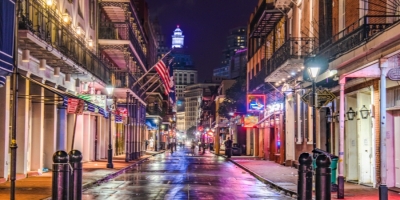Main Menu
-
Itineraries & Vacations
- Itineraries & Vacations
- BY TYPE
- Escorted Group Tours
- Road Trips in The US™
- BY INTEREST
- Route 66
- National Parks
- BY SPECIAL OFFER
- GIFT CARD
- Discount Coupons
- Tours in Major Cities
-
Travel Guides
- Travel Guides MOST VISITED CITY
- New York City Guide
- TOUR GUIDES BY CITY
- Miami - Travel Guide
- Los Angeles - Travel Guide
- San Francisco - Travel Guide
- Las Vegas - Travel Guide
- Chicago - Travel Guide
- Washington DC - Travel Guide
- Boston - Travel Guide
- San Diego - Travel Guide
- Orlando - Travel Guide
- New Orleans - Travel Guide
- TRAVELING IN THE US
- Good to Know
- Lodgings
- Disney Travels™
Best Time to Visit New Orleans: Weather, Events, and Travel Tips
Weather, Events, and Travel Tips Categories: New Orleans - Travel Guide - What to Know
If San Diego has a dry subtropical climate, New Orleans definitely has a humid subtropical climate! The sweltering heat and frequent heavy rains make summer the most challenging and least recommended season to visit New Orleans. Temperatures and Rainfall in New Orleans
New Orleans' climate effectively creates two macro-seasons; forget the traditional four seasons. To simplify, we consider just the summer and winter seasons. Temperatures remain mild during the winter season, making outdoor activities, including walking tours of the city, enjoyable.In contrast, during the summer season, humidity makes the air heavy and increases the sensation of heat, and the heavy rains make it difficult to explore the various neighborhoods. Additionally, this period marks the start of the hurricane season.
Rainfall is abundant all year round but intensifies during the summer season, from May to late September, and starts to decrease in October.
Let's take a look at a summary table of temperatures and rainfall.

Winter in New Orleans
January and February are the months with the lowest minimum temperatures, almost never below 45°F (7°C), while the averages are around 54°F (12°C) reaching highs of 60-64°F (16-18°C). So, we’re talking about a mild winter with never too heavy rainfall. The climate is therefore favorable for outdoor activities and exploring historic neighborhoods.With such favorable weather, there is no shortage of events and festivals, from jazz music festivals to the magical Mardi Gras of New Orleans.

Summer in New Orleans
In summer, starting from June, the heat is felt, the rains become more abundant, and the hurricane season begins. Maximum temperatures exceed 86-95°F (30-35°C) and the humidity makes everything heavier. It is difficult to explore the city, and if you have a choice, these are the least recommended months for travel.Spring and Fall in New Orleans
Spring (March/April/May) is the most variable season with pleasant nighttime minimum temperatures ranging from 55-60°F (13-16°C) while daytime temperatures can reach up to 77-86°F (25-30°C). Particularly sunny days will be the hottest, with refreshing sea breezes providing relief.October marks the start of the dry season, with scarce rainfall and temperatures gradually dropping to 61-66°F (16-19°C) in November. Undoubtedly, the best season for a trip to this area of the United States and to visit the Jazz capital: New Orleans.
The Best Time to Visit
If you have the option to choose, avoid the summer and visit New Orleans and its surroundings from October to April, remembering that you will find more events during the winter months.
We are your
local Tour Agency
in New York City
local Tour Agency
in New York City
Tailored Vacations
Secure Bookings
Your peers love it!
Your vacation, your way!
Free cancellation
BECAUSE IT'S OKAY TO CHANGE PLANS
Planning a vacation shouldn't be stressful. We all know plans might change, that is why we offer free cancellation for most of our services and tours. *
*exclusions may apply, please refer to each tour.
Planning a vacation shouldn't be stressful. We all know plans might change, that is why we offer free cancellation for most of our services and tours. *
*exclusions may apply, please refer to each tour.
What They
Say
Say
Devonnec770 | TripAdvisor
I’m the biggest fan of Fall activities, but haven’t had a chance to do anything beyond Apple Picking in NJ. I decided to take a last minute 2 day trip with a friend in Hudson Valley, but didn’t know where to start [...] Thankfully I was able to use New York Welcome to do the hard work for us [...]
From TripAdvisor - October 2021
Breanna A. | TripAdvisor
Irene was a FANTASTIC tour guide! She was so knowledgeable about the area and was so patient with all our questions. We stopped to use the bathroom and we got coffee halfway through, she was so kind! It was a pleasure learning about Brooklyn from you!
From TripAdvisor - April 2022
Keep in contact
Subscribe to our "New York x USA Welcome" Newsletter to receive Tips & Special Offers to help you plan your travels in the US!
Sightseeing & City Tours in Major Cities
- Brunch Cruise, Champagne & Live Music in San Francisco
- San Francisco Grand City Tour & Escape from the Rock Bay Cruise
- Escorted City Tour and Universal Studios entrance Ticket in LA
- 1 Day tour to Solvang, Hearst Castle and Santa Barbara from LA
- Chicago CityPASS
- Whale Watching Cruise in The Boston Bay
Escorted Group Tours - Traveling in The US with a Group
Private Transfer in Major Cities
Our Destinations in The USA
The US - Good to know
General Information
Office








